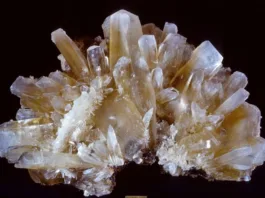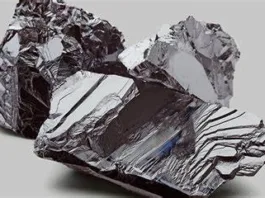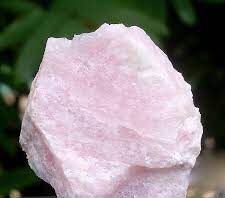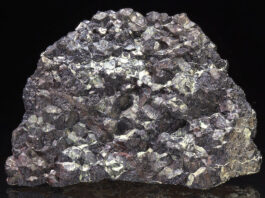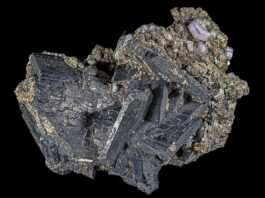Aluminum ore, also known as bauxite, is a naturally occurring mineral rock that contains aluminum in the form of aluminum oxide (Al2O3) mixed with various impurities. Bauxite is the primary source of aluminum, which is one of the most abundant elements in the Earth’s crust, comprising about 8% by weight.

Characteristics of aluminum ore (bauxite) include:
- Composition: Bauxite is primarily composed of aluminum oxide (Al2O3), but also contains other minerals, such as iron oxide, silica, titanium dioxide, and other impurities.
- Appearance: Bauxite is usually reddish-brown to white in color, with a dull to earthy luster. It often forms as a mixture of clay-like materials, small rock fragments, and minerals.
- Hardness: Bauxite has a hardness ranging from 1 to 3 on the Mohs scale, which means it is relatively soft compared to many other minerals.
- Occurrence: Bauxite is typically found in tropical and subtropical regions, usually in shallow, horizontal layers near the surface of the Earth. It is often associated with laterite soils, which are rich in iron and aluminum.
- Formation: Bauxite is formed through the weathering of aluminum-rich rocks, such as granite and basalt, over millions of years. The process involves the leaching of aluminum from the parent rock and its subsequent deposition in low-lying areas.
- Abundance: Bauxite is abundant globally, with large deposits found in countries such as Australia, Guinea, Brazil, Jamaica, and China, among others.
- Extraction: Bauxite is extracted through open-pit mining, and the ore is then processed through various methods to extract aluminum, such as the Bayer process and the Hall-Héroult process.
- Uses: Aluminum extracted from bauxite is used in a wide range of applications, including in the production of aluminum metal, as well as in the manufacturing of automotive parts, aircraft components, packaging materials, electrical wires, construction materials, and many other products.
Overall, aluminum ore (bauxite) is a widely available and economically important mineral that serves as the primary source of aluminum, a versatile metal used in various industries and applications.
Contents
- Importance of aluminum as a metal
- Aluminum Ore Minerals
- Examples of aluminum-bearing minerals and their occurrences
- Geology and Formation of Aluminum Ore Deposits
- Types of aluminum ore deposits and their characteristics
- Exploration and Evaluation of Aluminum Ore Deposits
- Mining and Processing of Aluminum Ores
- Occurrence and Distribution of Aluminum Ore Worldwide
- Uses of Aluminum and Aluminum Products
- Recap of key points about aluminum ore
Importance of aluminum as a metal
Aluminum is an important metal due to its unique combination of properties, making it a valuable material in various industries and applications. Some of the key reasons for the importance of aluminum as a metal are:
- Lightweight: Aluminum is a lightweight metal, about one-third the weight of steel, which makes it ideal for applications where weight reduction is important, such as in the aerospace, automotive, and transportation industries. Its low density also makes it easier to handle and transport.
- High Strength-to-Weight Ratio: Despite being lightweight, aluminum has high strength-to-weight ratio, making it strong and durable. This makes it suitable for applications where strength and durability are required, such as in the construction of buildings, bridges, and other structures.
- Corrosion Resistance: Aluminum has excellent corrosion resistance, as it forms a natural oxide layer on its surface that protects it from corrosion in many environments. This makes it ideal for applications in corrosive environments, such as in marine, automotive, and chemical industries.
- Electrical Conductivity: Aluminum is an excellent conductor of electricity, making it widely used in electrical transmission lines, power distribution networks, electrical wiring, and other electrical applications.
- Thermal Conductivity: Aluminum has good thermal conductivity, which makes it suitable for applications in heat exchange and heat dissipation, such as in radiators, heat exchangers, and other cooling systems.
- Recyclability: Aluminum is highly recyclable, and recycling aluminum requires only a fraction of the energy needed to produce aluminum from raw materials. This makes aluminum a sustainable and environmentally friendly material, with a high recycling rate.
- Versatility: Aluminum is a versatile metal that can be easily alloyed with other elements to obtain specific properties, making it suitable for a wide range of applications, from packaging materials to aerospace components to consumer goods.
- Abundance: Aluminum is the third most abundant element in the Earth’s crust, making up about 8% by weight, which means it is widely available and economically viable for various applications.
Overall, the unique properties of aluminum, such as its lightweight, high strength-to-weight ratio, corrosion resistance, electrical and thermal conductivity, recyclability, versatility, and abundance, make it a highly important metal in modern industries and applications.
Aluminum Ore Minerals
Aluminum ore minerals, also known as aluminum-bearing minerals or aluminum-containing minerals, are naturally occurring compounds that contain aluminum as a primary constituent. Aluminum is not found in its pure form in nature, but rather occurs in various minerals that are mined and processed to extract aluminum metal. Some common aluminum ore minerals include:
- Bauxite: Bauxite is the primary ore for aluminum and is the most abundant aluminum ore. It is a mixture of various aluminum hydroxide minerals, such as gibbsite (Al(OH)3), boehmite (γ-AlO(OH)), and diaspore (α-AlO(OH)), along with other minerals, such as hematite, goethite, and quartz.
- Feldspar: Certain types of feldspar, such as albite and anorthite, can contain significant amounts of aluminum and are considered as aluminum ore minerals. Feldspar is a group of rock-forming minerals that are important in the production of ceramics, glass, and other industrial products.
- Cryolite: Cryolite (Na3AlF6) is a rare aluminum-containing mineral that was historically used as a flux in the production of aluminum. However, it is now mostly produced synthetically as it is scarce in natural deposits.
- Kaolinite: Kaolinite (Al2Si2O5(OH)4) is a clay mineral that can contain aluminum and is used in the production of ceramics, paper, paint, and other applications.
- Alunite: Alunite (KAl3(SO4)2(OH)6) is a potassium aluminum sulfate mineral that can be used as a source of aluminum.
These are some of the common minerals that contain aluminum and are considered as aluminum ore minerals. These minerals are typically mined and processed to extract aluminum metal through various extraction methods, such as Bayer process, Hall-Héroult process, and other electrolytic and chemical processes.
Examples of aluminum-bearing minerals and their occurrences
Here are some examples of aluminum-bearing minerals and their occurrences:
- Bauxite: Bauxite is the main ore of aluminum and is typically found in tropical and subtropical regions, such as Guinea, Australia, Brazil, Jamaica, and India. Bauxite is a sedimentary rock composed mainly of aluminum hydroxide minerals, including gibbsite, boehmite, and diaspore, along with other minerals like hematite, goethite, and quartz.
- Feldspar: Feldspar is a group of rock-forming minerals that are important sources of aluminum. Albite and anorthite are two common types of feldspar that contain aluminum. Feldspar minerals are widely distributed and can be found in various igneous and metamorphic rocks, as well as in sedimentary rocks.
- Cryolite: Cryolite is a rare mineral that contains aluminum and is typically found in granite pegmatites and greisens. It has been found in a few locations around the world, including Greenland, Norway, and the United States.
- Kaolinite: Kaolinite is a clay mineral that contains aluminum and is commonly found in weathered rocks and soils. It is widespread and can be found in many countries, including the United States, Brazil, China, and the United Kingdom.
- Alunite: Alunite is a potassium aluminum sulfate mineral that is typically found in hydrothermal deposits. It has been found in various locations around the world, including the United States, Italy, Russia, and China.
- Corundum: Corundum is a crystalline form of aluminum oxide and is one of the hardest minerals known. It is typically found in metamorphic and igneous rocks, and can be found in various colors, including blue, red, pink, yellow, and colorless. Corundum is mined as a gemstone, but its industrial varieties, such as ruby and sapphire, are also used in various applications, including abrasives, cutting tools, and watch components.
These are just a few examples of aluminum-bearing minerals and their occurrences. Aluminum can also be found in other minerals and mineral deposits around the world, and the specific occurrences and distribution of these minerals can vary depending on local geological conditions.

Geology and Formation of Aluminum Ore Deposits
Aluminum ore deposits form through a complex interplay of geological processes. The most important type of aluminum ore deposit is bauxite, which is a sedimentary rock composed mainly of aluminum hydroxide minerals. The formation of bauxite deposits involves several key geological processes, including weathering, erosion, transportation, and deposition.
- Weathering: Bauxite deposits typically form in tropical and subtropical regions with high rainfall and warm temperatures, where intense weathering of rocks occurs. Chemical weathering of rocks rich in aluminum minerals, such as feldspars, leads to the release of aluminum ions into the soil solution.
- Erosion and Transportation: The aluminum ions released during weathering are transported by water through streams and rivers, and can be carried over long distances. The aluminum ions are often complexed with organic and inorganic ligands, which help to transport them in solution.
- Deposition: When the aluminum-bearing water reaches a region with a low water velocity, such as a floodplain or a delta, the aluminum ions can precipitate and accumulate as bauxite deposits. Bauxite deposits typically form in low-lying areas where water accumulates and can lead to the formation of extensive deposits.
- Diagenesis and Lithification: Over time, the accumulated bauxite deposits undergo diagenesis and lithification, which involves the compaction and cementation of the bauxite sediments to form a solid rock. This process may also involve the incorporation of other minerals, such as hematite, goethite, and quartz, which can affect the composition and properties of the bauxite deposit.
The specific geology and formation of aluminum ore deposits can vary depending on local geological conditions, including the type of rocks, climate, and geomorphology of the region. Bauxite deposits are typically found in tropical and subtropical regions with high rainfall and warm temperatures, but they can also occur in other environments, such as in temperate and even arctic regions, depending on the geological conditions. Understanding the geology and formation of aluminum ore deposits is important for the exploration and mining of aluminum resources.

Types of aluminum ore deposits and their characteristics
Aluminum ore deposits can be broadly classified into three main types based on their geological characteristics: bauxite deposits, lateritic deposits, and primary deposits.
- Bauxite deposits: Bauxite is the most important type of aluminum ore, and bauxite deposits are the primary source of aluminum worldwide. Bauxite deposits are typically formed by weathering and erosion of aluminum-rich rocks, such as feldspars and mica, in tropical and subtropical regions with high rainfall and warm temperatures. Bauxite deposits are usually found as shallow, flat-lying deposits, often occurring in extensive plateaus or hills. Bauxite deposits are typically composed of a mixture of aluminum hydroxide minerals, such as gibbsite, boehmite, and diaspore, along with other minerals, such as hematite, goethite, and quartz.
- Lateritic deposits: Lateritic deposits are another type of aluminum ore deposit that forms through weathering and leaching of aluminum-rich rocks, but they occur in regions with lower rainfall and less intense weathering compared to bauxite deposits. Lateritic deposits are typically found in tropical and subtropical regions, but they can also occur in other environments, such as arid and semi-arid regions. Lateritic deposits are characterized by a thick weathering profile, consisting of a layer of bauxitic or ferruginous (iron-rich) clay, called laterite, overlying a layer of unaltered rock. Lateritic deposits can contain aluminum hydroxide minerals, such as gibbsite and boehmite, along with other minerals, such as hematite, goethite, and kaolinite.
- Primary deposits: Primary aluminum ore deposits are those that contain aluminum minerals in their original form, without significant weathering or alteration. Primary deposits are typically associated with igneous and metamorphic rocks, and they can occur in various geological settings, such as volcanic rocks, pegmatites, and metamorphic rocks. Primary deposits are relatively rare and less economically important as a source of aluminum compared to bauxite and lateritic deposits.
The characteristics of aluminum ore deposits can vary depending on their type and geological setting. Bauxite deposits are typically shallow, flat-lying, and extensive, with a mixture of aluminum hydroxide minerals and other minerals. Lateritic deposits are characterized by a thick weathering profile and contain laterite, a clay-rich layer, overlying unaltered rock. Primary deposits can occur in various geological settings and may contain different types of aluminum minerals. Understanding the characteristics of different types of aluminum ore deposits is important for the exploration and mining of aluminum resources.

Exploration and Evaluation of Aluminum Ore Deposits
Exploration and evaluation of aluminum ore deposits typically involve several steps, which can vary depending on the type of deposit being targeted (e.g., bauxite, lateritic, or primary deposit) and the specific geological setting. Here are some general steps involved in the exploration and evaluation process:
- Desk-based studies: The initial stage of exploration involves reviewing existing geological maps, reports, and data to identify areas with potential for aluminum ore deposits. This can include studying regional geology, climate, and other relevant factors to identify favorable geological settings for aluminum ore formation, such as areas with known occurrences of aluminum-bearing minerals or rocks.
- Field surveys: Field surveys are conducted to collect geological data, including rock samples, soil samples, and stream sediment samples, to assess the presence of aluminum minerals or rocks in the target area. Geologists may also map the distribution and characteristics of rock units, structures, and alteration zones in the field to gain insights into the geological history of the area and identify potential aluminum ore prospects.
- Geophysical surveys: Geophysical methods, such as magnetic, electromagnetic, and radiometric surveys, can be used to identify subsurface features associated with aluminum ore deposits. For example, some aluminum ore deposits can exhibit distinctive geophysical signatures, such as anomalies in magnetic or radiometric data, which can be used as indicators of potential mineralization.
- Geochemical analyses: Geochemical analyses of rock, soil, and stream sediment samples can provide valuable information on the presence and distribution of aluminum minerals. This may involve laboratory analyses to determine the elemental composition of samples, including aluminum and other relevant elements, as well as the use of geochemical techniques, such as geochemical mapping or stream sediment surveys, to identify anomalies or trends that may indicate the presence of aluminum mineralization.
- Drilling: If the results of the initial surveys are promising, drilling may be conducted to collect core samples from the subsurface for detailed analysis. Core samples can provide important information on the composition, structure, and mineralogy of the rocks, as well as the extent and grade of the aluminum ore deposit.
- Resource estimation: Based on the data collected from field surveys, geophysical surveys, and geochemical analyses, resource estimation can be performed to estimate the size, grade, and economic viability of the aluminum ore deposit. This involves using geological models, statistical methods, and other relevant data to estimate the tonnage, grade, and mineral content of the deposit.
- Economic evaluation: Once the resource estimation is complete, economic evaluation is conducted to assess the economic feasibility of mining and processing the aluminum ore deposit. This may involve considerations such as the estimated production costs, market demand, infrastructure availability, environmental and regulatory requirements, and other economic factors.
- Feasibility studies: If the economic evaluation is positive, further detailed studies, including metallurgical testing, environmental impact assessments, and engineering studies, may be conducted to assess the technical and economic viability of the project. Feasibility studies are typically comprehensive assessments that provide detailed information on the technical and economic aspects of mining and processing the aluminum ore deposit.
- Permitting and licensing: Obtaining the necessary permits and licenses from regulatory authorities is a crucial step in the exploration and evaluation process. This may involve obtaining permits for exploration, mining, and environmental compliance, as well as complying with other regulatory requirements, such as land use, water usage, and waste management.
Exploration and evaluation of aluminum ore deposits require a multidisciplinary approach, involving geology, geochemistry, geophysics, engineering, economics, and environmental considerations. It is important to follow best practices, regulations, and environmental standards throughout the exploration and evaluation process to ensure responsible and sustainable mining practices.

Mining and Processing of Aluminum Ores
Mining and processing of aluminum ores typically involve several stages, which can vary depending on the type of aluminum ore being mined (e.g., bauxite, laterite, or primary aluminum ores) and the specific mining and processing methods used. Here are some general steps involved in the mining and processing of aluminum ores:
- Clearing and preparation of the mining site: The first step in mining aluminum ores is to clear and prepare the mining site. This may involve clearing vegetation, removing topsoil and overburden, and constructing access roads and infrastructure.
- Extraction of aluminum ore: Depending on the type of aluminum ore, different extraction methods may be used. For bauxite, which is the most common aluminum ore, open-pit mining is typically employed. This involves using heavy machinery, such as bulldozers, excavators, and haul trucks, to remove the overlying soil and rock, exposing the bauxite ore underneath. Lateritic and primary aluminum ores may require different extraction methods, such as underground mining or quarrying.
- Crushing and grinding: Once the aluminum ore is extracted, it is typically crushed and ground into smaller particles to facilitate further processing. Crushing and grinding may be done using crushers, mills, or other size reduction equipment, depending on the ore type and desired particle size.
- Bayer process for bauxite: Bauxite ore is processed using the Bayer process, which involves dissolving the aluminum-bearing minerals in caustic soda (sodium hydroxide) solution, and then precipitating aluminum hydroxide through a series of chemical reactions. The aluminum hydroxide is then calcined to produce alumina (aluminum oxide), which is the primary raw material for producing aluminum metal.
- Electrolytic reduction for alumina: Alumina obtained from the Bayer process is then converted into aluminum metal through an electrolytic reduction process called the Hall-Héroult process. In this process, alumina is dissolved in a molten cryolite (sodium aluminum fluoride) electrolyte, and an electric current is passed through the electrolyte, causing aluminum ions to migrate to the cathode, where they are reduced to form molten aluminum metal.
- Smelting for other aluminum ores: For some primary aluminum ores, such as cryolite, aluminum fluoride, or aluminum chloride, smelting may be used as a processing method. Smelting involves heating the ore with a reducing agent, such as carbon or another metal, to extract the aluminum metal from the ore.
- Refining and casting: The molten aluminum metal obtained from the electrolytic reduction or smelting process is then refined to remove impurities, such as iron, silicon, and titanium, to produce high-purity aluminum metal. The refined aluminum metal is then cast into various shapes, such as ingots, billets, or slabs, depending on the desired final product.
- Recycling: Aluminum is a highly recyclable metal, and recycling of aluminum scrap is an important part of the aluminum production process. Recycling involves collecting, sorting, melting, and refining aluminum scrap to produce secondary aluminum, which can be used as a raw material for producing new aluminum products.
- Environmental considerations: Mining and processing of aluminum ores can have environmental impacts, such as land disturbance, water usage, energy consumption, and emissions of greenhouse gases and other air pollutants. Therefore, environmental considerations, including reclamation and rehabilitation of mined lands, water management, energy efficiency, and emissions control, are important aspects of responsible and sustainable aluminum production.
Mining and processing of aluminum ores require careful planning, engineering, and environmental management to ensure responsible and sustainable practices. Compliance with relevant regulations, best practices, and environmental standards is essential to mitigate the potential impacts on the environment and local communities

Occurrence and Distribution of Aluminum Ore Worldwide
Aluminum ore, primarily in the form of bauxite, is found in various regions around the world. Bauxite is the main source of aluminum and is typically found in tropical or subtropical regions with abundant rainfall and warm climates, which promote the weathering and formation of bauxite deposits. Here are some key points about the occurrence and distribution of aluminum ore worldwide:
- Bauxite deposits: Bauxite, which is the primary aluminum ore, is typically found in laterite-type deposits. Laterite is a type of soil that forms in tropical and subtropical regions with high rainfall and warm temperatures, which promote the weathering of rocks rich in aluminum minerals. Bauxite deposits are commonly found in areas with high precipitation and well-drained soils, such as in parts of South America, West Africa, Australia, and Southeast Asia.
- Major producing countries: The largest producers of bauxite, and therefore aluminum ore, are Australia, China, Guinea, Brazil, and India. These countries account for the majority of the world’s bauxite production, with other significant producers including Indonesia, Malaysia, Jamaica, and Russia.
- Reserves and resources: Bauxite reserves are estimated to be plentiful, with large deposits known to exist in various countries around the world. According to the United States Geological Survey (USGS), as of 2021, global bauxite reserves were estimated at about 30 billion metric tons, with the largest reserves located in Guinea, Australia, and Brazil. Bauxite resources, which refer to known deposits that may become economically viable in the future with advancing technology and market conditions, are estimated to be even larger.
- Distribution challenges: While bauxite deposits are found in various regions, the availability of economically viable deposits can be influenced by factors such as the quality and quantity of the ore, infrastructure, transportation, and environmental considerations. Some regions with large bauxite deposits may face challenges in terms of accessibility, infrastructure, and environmental regulations, which can affect the feasibility of mining and processing bauxite ore.
- Exploration and evaluation: The exploration and evaluation of bauxite deposits typically involve geological surveys, remote sensing, drilling, and sampling to determine the quality and quantity of the ore, as well as the feasibility of mining and processing. Economic, social, and environmental factors are also considered in the evaluation of bauxite deposits.
- Sustainable mining practices: Responsible and sustainable mining practices, including environmental management, reclamation, and rehabilitation of mined lands, are important aspects of aluminum ore mining. Environmental regulations, best practices, and social considerations play a crucial role in the sustainable extraction of aluminum ore, minimizing impacts on local communities and the environment.
The occurrence and distribution of aluminum ore worldwide are influenced by geological, environmental, economic, and social factors. Bauxite deposits are found in various regions with abundant rainfall and warm climates, and responsible mining practices are essential to ensure sustainable aluminum production.

Uses of Aluminum and Aluminum Products
Aluminum is a versatile metal with a wide range of uses and applications due to its desirable properties, such as its lightweight, corrosion resistance, high electrical and thermal conductivity, and recyclability. Here are some key points about the uses of aluminum and aluminum products:
- Transportation: Aluminum is widely used in the transportation industry due to its lightweight nature, which helps reduce fuel consumption and emissions in vehicles. It is used in the production of automobiles, aircraft, trains, boats, and bicycles, as well as in components such as engines, transmissions, wheels, and body parts.
- Packaging: Aluminum is used extensively in packaging materials due to its high strength, durability, and ability to be easily formed into various shapes. It is used in beverage cans, food containers, foil, and other packaging applications.
- Construction: Aluminum is used in the construction industry due to its lightweight, corrosion resistance, and ease of fabrication. It is used in a wide range of applications, including windows, doors, roofing, siding, curtain walls, structural components, and electrical wiring.
- Electrical and electronics: Aluminum is used in electrical and electronics applications due to its high electrical conductivity and good thermal conductivity. It is used in power transmission lines, electrical cables, electrical conductors, heat sinks, and other electronic components.
- Machinery and equipment: Aluminum is used in machinery and equipment due to its lightweight, high strength, and good machinability. It is used in manufacturing equipment, machine parts, tools, and various industrial applications.
- Consumer goods: Aluminum is used in various consumer goods, such as household appliances, cookware, sports equipment, furniture, and lighting fixtures, due to its lightweight, corrosion resistance, and attractive appearance.
- Renewable energy: Aluminum is used in renewable energy applications, such as solar panels, wind turbines, and electric vehicle components, due to its lightweight, corrosion resistance, and recyclability.
- Packaging: Aluminum is used extensively in packaging materials due to its high strength, durability, and ability to be easily formed into various shapes. It is used in beverage cans, food containers, foil, and other packaging applications.
- Other applications: Aluminum is used in many other applications, including aerospace, defense, medical, and consumer electronics, due to its unique combination of properties.
The uses of aluminum and aluminum products are diverse and widespread, with aluminum being a critical material in many industries and applications due to its desirable properties and sustainability aspects.

Recap of key points about aluminum ore
Here’s a recap of key points about aluminum ore:
- Aluminum ore is a type of rock or mineral that contains aluminum in the form of compounds, typically aluminum oxide (Al2O3) or aluminum hydroxide (Al(OH)3).
- Aluminum is an important metal due to its desirable properties, such as its lightweight, corrosion resistance, high electrical and thermal conductivity, and recyclability.
- Common aluminum ore minerals include bauxite, which is the primary source of aluminum, as well as gibbsite, diaspore, and boehmite.
- Aluminum ore minerals typically occur in sedimentary, lateritic, and residual deposits, and their occurrence and distribution worldwide are influenced by various geological and environmental factors.
- Aluminum ore deposits are often explored and evaluated through geological surveys, geophysical and geochemical techniques, and drilling and sampling methods.
- Mining and processing of aluminum ores involve extraction of the ore, followed by refining to obtain aluminum metal, which can be done through various methods, including open-pit mining, underground mining, and refining processes such as Bayer process and Hall-Héroult process.
- Aluminum and aluminum products are used in a wide range of industries and applications, including transportation, packaging, construction, electrical and electronics, machinery and equipment, consumer goods, renewable energy, and others.
- The aluminum industry faces challenges such as fluctuating aluminum prices, environmental and social concerns related to mining and processing, energy consumption, and recycling and sustainability issues.
- Aluminum is a critical material in many industries and applications due to its desirable properties and sustainability aspects, and its use continues to play a significant role in modern society.
Overall, aluminum ore is an important source of aluminum, which is a versatile metal with a wide range of uses and applications in various industries, and its mining, processing, and use are influenced by geological, environmental, economic, and societal factors.

